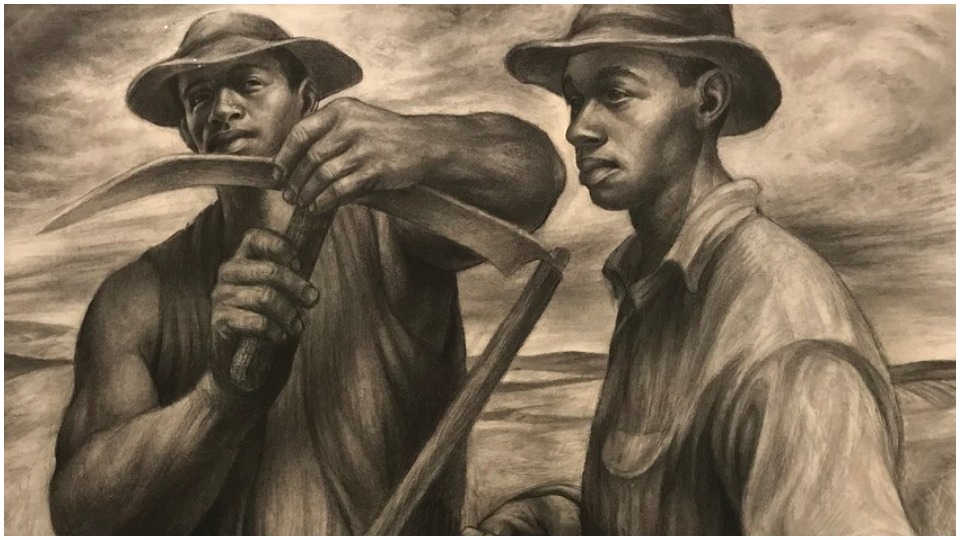
LOS ANGELES—Right now, the critical thing to say about the magnificent Charles White retrospective at the Los Angeles County Museum of Art (LACMA) is that it closes June 9! Sorry, the time flew and I did not get to it until a couple of days ago.
A retrospective exhibition aims at a universal glance back at an artist’s entire oeuvre, usually not focusing on a particular theme or medium. This gives a new audience, or the upcoming generation, the opportunity to become acquainted with the artist’s work in person, rather than only through books or films. The curators will, of course, be influenced by their own biases, but more importantly by how a retrospective will bring out aspects of the artist’s work that perhaps now seem more visionary, or more astute, than could be appreciated earlier. In other words, if there’s going to be a retrospective, the museum must ask, Why now, and for whom?
LACMA has mounted the first major 21st-century museum retrospective on this famed mid-century artist. It is overdue, and one can only hope that major art institutions around the country will be inspired to produce their own versions of it, with appropriate programming around it to appeal to the public.
Charles White is more vital than ever. The subject matter he addressed, the condition of Black America, may be in many people’s eyes not much further advanced than when he started making art in the 1930s. In this era of Trumpery—and in future decades under the rule of reactionary jurists appointed during the present regime—minority rights are likely to suffer even further assault.
Charles White: A Retrospective traces the artist’s career framed in three periods marked by the cities where he lived: Chicago, his birthplace; New York, where he joined his talent to social causes and attracted attention and acclaim; and finally Los Angeles, where he matured as a civil rights and arts activist.
The generous exhibition includes approximately 100 drawings and prints, the work he is most remembered by, alongside a few paintings. With his flawless draftsmanship, White created images of both historical and contemporary African Americans, depicted in both heroic portraits and in everyday scenes. Their common humanity lifted the ordinary into the extraordinary and made even the few well-known public figures he depicted seem as though they had just stopped by for a friendly cup of coffee.
His subjects’ dignity and self-confident presence stand in silent rebuke to this country’s long history of racial injustice (400 years of slavery, Jim Crow, and enforced servitude). In every direction White turned his gaze, he found people and imagery to remind viewers of ongoing problems of race, expressed in institutionalized violence, poverty, and discrimination in education, housing, hiring, voting and other areas of life.
Over the course of his life, Charles White (1918-1979) became one of the most significant artists of the American mid-century. Although his focus remained almost exclusively on Black America, his work illuminated one of the seminal fractures in the larger society—the failure to secure full democracy for all Americans. His particular concern took on universal relevance, and it is that quality that bears re-examination through periodic retrospective reminders.
Coming of age in the 1930s, during the Great Depression, White drew on the rich history of other artists before him and in his own day who brought social consciousness into their work. The life of a studio artist may seem quiet and removed, but the work can shout out protest, affirmation, and celebration. As he declared in 1940, “Paint is the only weapon I have with which to fight what I resent.” He advanced the cause of civil and human rights in his striking depictions of Black men and women both in repose and in struggle.
The legacy he left of artistic activism, bringing together superb craft and aesthetic insight, continues to inspire and give courage to all who fight for a better world.
White lived in Chicago for his first 24 years, from 1918 to 1942, where he studied at the Art Institute of Chicago and became aligned with the New Negro Movement, or the Chicago Black Renaissance, and a more extended network of local leftist artists who sought social change. He created murals drawn from African-American history under the auspices of the Works Progress Administration’s Federal Art Project and was influenced, as many other public artists were at the time, by Mexican muralists such as Diego Rivera, who believed that art should reach the broadest possible audience.
To that end he also made affordable prints and reproductions and participated in joint community exhibitions. His subject material often derived from folktales, the Bible and spirituals, trying to counter mainstream ignorance and cover-ups of Black achievement. He recognized the continuity between that historical mistreatment of African-Americans and present-day injustices facing Black people in his own time.
With his first wife Elizabeth Catlett, a renowned artist in her own right, White relocated to New York City, where he lived until 1956. He taught art and exhibited widely, especially in progressive circles. In response to World War II, he created images of African Americans in the military and on the home front, believing that the Western democracies could defeat fascism only with a united front that not only included people of all races but held out the promise of material betterment after the war.

In Soldier (1944), created at the height of the war, the artist offers a deeply ambivalent view. Instead of a propagandistic celebration of heroism in action, it reveals a more nuanced and pointed interpretation. African-Americans were appealed to by right-wing, pro-fascist forces to withhold their support for the U.S. war effort on the grounds that there was nothing in the war that would benefit them. Although the figure bravely lunges forward, his face expresses uncertainty as he nervously contemplates the unknown. Is the stormy sky a reflection of wartime reality or the ominous premonition of lingering racism? It represents the dilemma faced by African-American soldiers who fought on behalf of a nation that simultaneously denied them their full rights as citizens.
White himself served in a segregated division of the army. There he contracted tuberculosis, which permanently damaged his health, and he was discharged. In The Return of the Soldier (Dixie Comes to New York) created in 1946, the artist’s post-war fears are realized: African-American soldiers came back home to exactly the same repressive, segregationist conditions they left. Restricted housing, urban ghettos, and anti-minority covenants in the North and West echoed the strict apartheid of the South. Many must have wondered, What did we fight for? That predicament is the theme eloquently explored in the 2017 film Mudbound.
Another 1946 print is Can a Negro Study Law in Texas? The image references the case of Heman Sweatt, who applied to the University of Texas School of Law, which did not accept Black applicants. Sweatt filed a lawsuit against the school in 1950 in collaboration with the NAACP. His case prevailed in the Supreme Court. This drawing originally illustrated an article that appeared in the Communist periodical New Masses, showing Sweatt standing behind a fence, a book in one hand, ready to hurl a lightning bolt with the other. The image recalls the satirical drawings that French artist Honoré Daumier used to lambaste the judicial system.

In 1946, he accompanied his wife to Mexico where he worked at the famed printmaking collective Taller de Gráfica Popular. Back home in New York, he became involved with the Interracial Committee for the Negro in the Arts, founded in 1947 with support from Harry Belafonte, Paul Robeson, and Langston Hughes. That group advocated for the integration of African Americans into all areas of American life.
In an era when Abstract Expressionism became the dominant post-war, Cold War esthetic (with fervent State Department endorsement so as to prove the superiority of free-market freedoms), White’s realism can only be seen as a conscious political choice. In 1951, as hearings of the House Un-American Activities Committee threatened to blacklist many leftist artists, White and his second wife, Frances Barrett White, whom he married in 1950, daringly traveled “behind the Iron Curtain” to the forbidden Soviet Union. There, he encountered Socialist Realism, the propagandistic artistic style that featured monumental figures and optimistic views of workers. The Soviet esthetic conformed in the most significant ways to his own style of elevating themes of labor, agriculture, and popular culture. With the strong encouragement of socialist favor for representational art, White gave renewed emphasis in his art to the dignity and beauty of Black people.

In his Harvest Talk (1953), seen at the top of this article, White depicts a team of farmers—Southern sharecroppers perhaps—sharpening a scythe. So soon after his visit to the USSR, the presence of a scythe is a likely reference to the many agriculturally themed works he had undoubtedly seen there. Are these Black farmers talking only about the harvest out there isolated against a threatening, turbulent sky? Or are we invited to imagine something subversive, something that will sharply upset the natural order?
The Whites moved to warmer, drier Los Angeles for health reasons in 1956. There, his network expanded to include personalities such as actor Sidney Poitier and screenwriter Dalton Trumbo, and his art appeared in Hollywood projects. From the 1960s on, White worked primarily as a draftsman and printmaker, creating large-scale, monumental images of single figures set into increasingly complex and abstract contexts. He aligned his work with the emerging artistic expression growing out of the Black Power movement in the mid-1960s and early 1970s. Although he did not formally adopt overtly revolutionary symbols often featured by the younger artists, his work continued to show frustration over the slow progress, and sometimes setbacks, in civil rights.
In 1965 he joined the faculty of the Otis Art Institute, where he trained a generation of artists, many of whom would develop their own socially committed practice. By the time of his death in 1979, White had become not only active in the cultural politics of Los Angeles and a cult hero of California art circles but had been recognized as a significant international figure.
White allowed Love Letter I to be used in the campaign to free Angela Davis in connection with her 1970 murder trial, in which she was acquitted in 1972 after a worldwide campaign demanded her release. She has a clearly intended Afro halo, which Davis and many others wore at the time as a symbol of Black liberation.
Two complementary exhibitions are on view in Los Angeles. Life Model: Charles White and His Students runs through Sept. 14, 2019, at LACMA’s satellite gallery at Charles White Elementary School (formerly Otis Art Institute), at 2401 Wilshire Blvd., Los Angeles 90057 at MacArthur Park. Also Plumb Line: Charles White and the Contemporary, running through Aug. 25, 2019, at the California African American Museum, 600 State Dr., in Exposition Park, Los Angeles 90037, whose mission to showcase African-American history, art, and culture was shared by White throughout his career.

MOST POPULAR TODAY

After months of denial, U.S. admits to running Ukraine biolabs

Ohio: Franklin County treasurer attends Netanyahu meeting, steps up Israel Bond purchases

‘Warning! This product supports genocide’: Michigan group aims to educate consumers

“Trail of Tears Walk” commemorates Native Americans’ forced removal







Comments